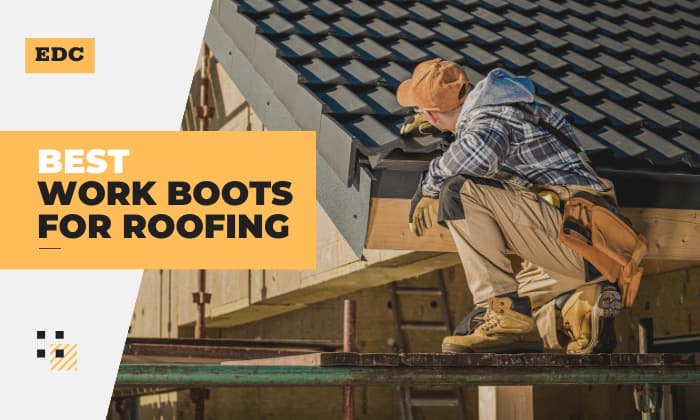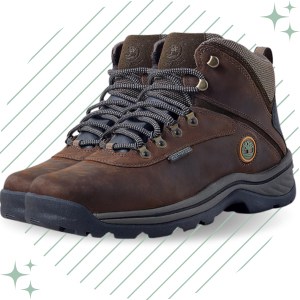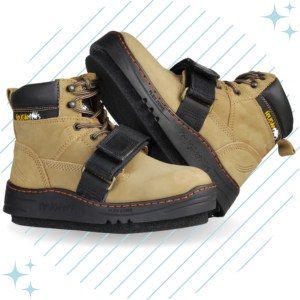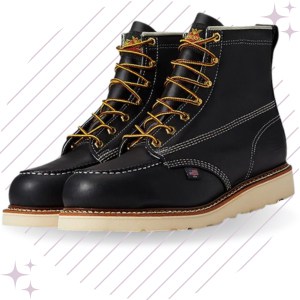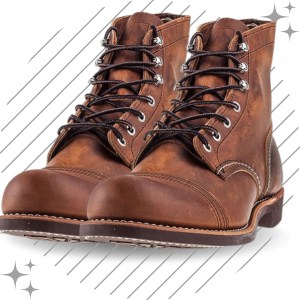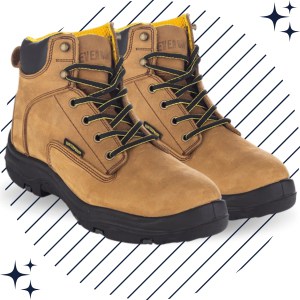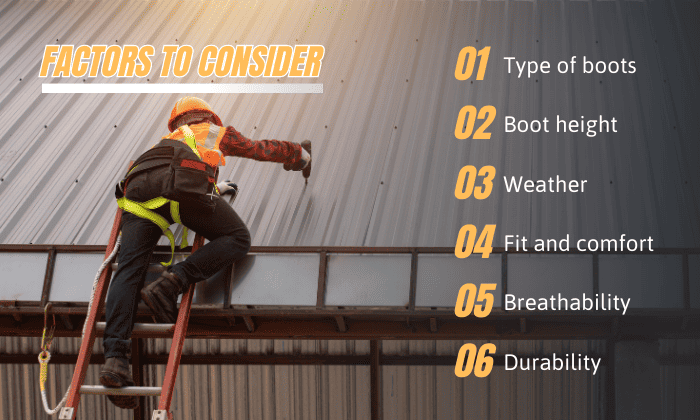Anyone in the roofing industry knows they should never climb up without their tie-off systems, guardrails, brackets, and helmets.
Although the Occupational Safety Health Administration (OSHA) does not have guidelines for roofing footwear, it’s best practice to wear shoes that can protect you while preventing dents, scuffs, and other damage to the shingles.
Let me explain this further as I discuss the three shoe components that you should check when shopping for the best work boots for roofing:
- High traction soles: Always check whether the shoes have grippy rubber soles. Manufacturers design soles with deeper lugs compared to your average casual shoes, and their patterns vary depending on the surface workers.
If you’re looking for shoes for metal roofing or clay tile roofs, opt for models with soles that have smaller shapes. When working on asphalt shingles, choose shoes with larger patterns on the soles.
- Non-marking soles: Tougher soles can dent or scratch the shingles, especially during warmer seasons when the sun tenderizes the roof regardless of its material. To minimize the chances of damaging your client’s roof, wear shoes with softer soles.
- Other types of foot protection: Only your safety officer can identify the hazards on the job site and recommend the appropriate type of protection.
For example, if you are walking on debris, carrying bundles of shingles, or exposed to open wires, your employer may require you to wear safety-toe boots made of puncture-proof materials that meet an electrical hazard rating.
These features only address safety concerns for solar installers and roofers. As workers, we also care about comfort, style, and durability. Don’t worry; you can read more about these in the “Factors to consider” section. For now, let me tell you why I’m recommending the following shoes for roofing work.
Table of Contents
Top 6 Work Boots for Roofing
1. WOLVERINE Overpass boot
- Shaft height: 6″
- Upper material: Waterproof leather
- Toe protection: Composite toe with ASTM F2413-18 M/I/C EH rating
- Outsole: Dual compound rubber and PU
- Insoles: Removable Ortholite cushioned footbed
Wolverine is one of my favorite brands mainly because it manufactures highly durable, protective, and comfortable work boots at an affordable price. One such example is the Overpass. I’ve walked in them on various floorings, roofs, and terrains, yet they have been holding up well for over a year.
Although it is not explicitly marketed toward roofers, this particular model features abrasion-, chemical-, slip-, oil-, and water-resistant outsoles. Moreover, the tread patterns do not damage the roofing materials. Plus, they can shed dirt quickly, making cleaning and maintaining them effortless.
This model can protect my feet against electrical hazards and the impact of falling objects thanks to its composite toes without compromising comfort. I often forget that these are safety toes because they’re so lightweight and comfy. Their leather uppers flex as I walk, while the Ortholite cushioned footbeds absorb the shock in every step.
Lastly, let me add that the brand also offers half-sizes and wide options to fit diverse foot shapes.
My only problem is that they can feel toasty during summer. For me, these are good boots for winter, considering that the shoes are designed with insulation, so they’re better at keeping your feet warm.
- Highly durable, protective, and comfortable work boots at an affordable price
- Features abrasion-, chemical-, slip-, oil-, and water-resistant outsoles
- The tread patterns do not damage the roofing materials
- Effortless to clean and maintain
- Ultra lightweight and comfy design while ensuring the wearer’s safety
- May feel a little hot during the summer
2. Timberland Men’s White Ledge Waterproof Mid-Hiker boot
- Shaft height: 4.75″ from arch
- Upper material: Full-grain leather
- Toe protection: None
- Outsole: Rubber
- Insoles: Undisclosed
Even though Timberland designed and advertised the White Ledge as hiking boots, I find that their functionalities make for an excellent pair of non-slip roofing shoes. To be honest, I also use them when I’m running errands, gardening, and working on carpentry projects. Hands down, these are one of the most versatile boots on the market.
I’m amazed that their outsoles perform well on roofs, slippery floors, wet soils, gravels, and uneven terrains. Besides the shock-absorbent soft EVA footbed and midsole, these flexible premium uppers make the boots perfect for long hours of work. As such, the boots effortlessly conform to my feet while I’m crawling, kneeling, or climbing ladders.
The manufacturer uses a seam-sealed construction technique and waterproof leather to prevent moisture penetration during inclement weather. In my experience, they are also effective in keeping my feet dry.
However, what is even more impressive is that the lining is made of ReBOTL fabric, composed of 50% recycled PET bottles. I think integrating recycled materials into brand-new items is a smart way to reduce plastic waste and carbon footprint.
However, the padding rubbed my ankle raw when I first wore these. Since then, I started wearing these boots with longer and thicker socks, and they no longer hurt me.
- Versatile boots that can serve everyday purposes
- Offer excellent grip on roofs, slippery floors, wet soils, gravels, and uneven terrains
- Flexible soles that easily conform to the wearer’s feet during various activities
- Feature a seam-sealed construction technique and waterproof leather to prevent water penetration
- The lining is made of ReBOTL fabric
- The padding rubs may rub the wearer’s ankles
3. Cougar Paws Performer roofing boot
- Shaft height: 6”
- Upper material: Leather
- Toe protection: Soft-toe
- Outsole: Rubber
- Insoles: Undisclosed
Out of all the brands I’m reviewing here, Cougar Paws is the only one that specializes in roofing footwear, as each pair is designed by roofers. Its flagship model, the Performer, boasts outsoles designed and tested for on a 12/12 pitch roof.
What makes them unique is the boots come with foam pads that make the shoes “stick” on most roofing materials, except for metal. Walking on shingles in them made me feel safe because of their slip-resistant soles.
For me, the best part is that the pads are replaceable. It saves me the trouble of spending hundreds of dollars on new shoes each time the lugs wear down—I just have to purchase the replacement pads. I also appreciate that the protective finish makes cleaning effortless, as I can maintain the shoes in tip-top shapes and improve their durability.
To help the user deal with hot temperatures, the manufacturer opts for breathable materials. As such, my feet remain dry and cool even when I work on a sunny day. Furthermore, the flexible mid-cut leather supports my feet without inhibiting movement.
Note that the shoes run big, which is something that I think online shoppers should be aware of. To be fair, the toe area is wide by design. Rest assured, the boots included straps over the leather uppers, allowing me to adjust them to a snugger and comfier fit.
- Designed and tested for on a 12/12 pitch roof by professional roofers
- Replaceable foam pads that make the shoes slip-resistant on most roofing materials
- Replaceable and affordable pads
- Breathable design to ensure the user’s feet remain cool and dry
- The flexible material provides proper support without restricting movements
- The shoes run a little big
4. Thorogood American Heritage Safety Toe-M 6” steel toe work boot
- Shaft height: 6”
- Upper material: Full-grain leather
- Toe protection: Steel toe
- Outsole: Maxwear Wedge™ Traction Outsole
- Insoles: Removable Ultimate Shock Absorption Footbed on Poron Comfort Cushion Insole
Proudly handcrafted by workers in the US, the American Heritage series is proof that work boots can be both functional and stylish. Among all the models within the collection, I think this black mod toe is most suited for roofing.
Just by looking at the shoe’s silhouette, one might not even guess that they are rated for high-risk workplaces. News flash: They do have steel toe caps that can protect the feet against the impact of falling objects.
Plus, these shoes meet the ASTM standard for electrical hazard safety. On the roof, the wedge rubber soles have ample traction to keep me from losing my footing. Together with the Comfort Cushion insoles, they minimize fatigue by absorbing the shock that comes with walking.
With uppers made of full-grain leather sewn to the soles using the Goodyear welt construction technique, these boots can certainly last years with good care. More importantly, their design gives me the option to re-sole in the future.
I’m happy with how moc toe boots are more spacious compared to round toes, giving me room to fit thicker socks. Since these shoes are incredibly breathable, I can wear thick socks for better shock absorption without worrying I’d sweat excessively.
As expected, full-grain leather boots can take a while to break in. Once the materials softened, they became the comfiest footwear I’ve ever owned.
- Feature steel toe caps to protect against the impact of falling objects
- Meet the ASTM standard for electrical hazard safety
- Ample traction to provide proper grip and prevent slip
- More spacious compared to round toes
- Breathable shoe design
- Can take a while to break in
5. Red Wing 8085 Men’s 6” boot
- Shaft height: 6”
- Upper material: Leather
- Toe protection: None
- Outsole: Vibram 430 Mini-lug sole
- Insoles: Leather insole
The Iron Ranger’s design was initially developed for iron miners back in the 1930s. Fast forward to this year, many people—including myself—wear these boots for business meetings, hiking, or even parties. Indeed, it’s a nice all-around pair that can make my outfits look stylish.
A true workhorse, the Red Wing shoemakers utilized a Goodyear welt and Puritan triple-stitch construction to ensure long-lasting durability and superb waterproofing. The uppers are made of hard-wearing, full-grain leather, which can age beautifully. When the sole inevitably wears down, they can be taken to cobblers to get re-soled.
Speaking of soles, these boots are equipped with oil-resistant Vibram 430 Mini-Lug outsoles. They can support me on rugged terrains and roofs. Plus, the lack of aggressive tread patterns helps me avoid damaging the roofing materials.
Meanwhile, the steel shank improves stability and distributes my weight more evenly. For added comfort, the manufacturer uses leather insoles that mold to my feet over time. I also love the shoes’ bump toes, which allow my toes to wiggle comfortably while still ensuring a snug fit.
Now, here’s the catch: The upper material is tough to break in. Aside from that, I think the soles are a bit too thin when working on a hot roof during summer, as my soles can still feel the heat.
- A nice all-around pair that can make any outfits look stylish
- Ensure long-lasting durability and superb waterproofing
- Leather ages beautifully
- Equipped with oil-resistant Vibram 430 Mini-Lug outsoles
- The steel shank improves stability and distributes the wearer’s weight more evenly
- Tough to break in
- The soles are a bit too thin when working on a hot roof during summer
6. EVER BOOTS ULTRA DRY work boot
- Shaft height: 6”
- Upper material: Waterproof leather
- Toe protection: None
- Outsole: Rubber sole
- Insoles: EverFit Anti-Fatigue removable insole
In my view, this pair from Ever Boots wins the low-cost roofing boots category. Apart from that, its main selling point is superior waterproof technology that can protect my feet against rain while simultaneously drawing away sweat. This makes them quite handy for general construction and utility jobs, gardening, and hiking.
Not to mention, the oil- and slip-resistant outsoles allow me to walk on wet floorings and traverse the roof pitch safely. Plus, the tread patterns do not pick up a lot of dirt when I walk on muddy ground, making cleaning them a breeze. To help me with my balance, the boots also feature a steel shank between the outsole and midsole.
On top of that, the leather uppers are super flexible; I didn’t even have to break these boots in. The height of the shafts is just enough to support my ankles while moving across the roof without rubbing uncomfortably against them. Overall, these boots provide me the comfort I need to get through the day without foot aches.
Unfortunately, the shoelaces broke after a couple of months. Besides that, the insoles feel a little flat. That said, these two items are widely available in the market, so it’s easy for me to replace them. In any case, I can’t complain since these are one of the most affordable work boots I had.
- Superior waterproof technology
- Extremely versatile
- Can walk on wet floorings and traverse the roof pitch without slipping
- The tread patterns do not pick up a lot of dirt when walking on muddy ground
- Do not need to be broken in
- Most affordable work boots
- The shoelaces are not very durable
- The insoles feel a little flat
Factors to Consider When Buying Work Boots for Roofing
1. Type of boots
Wearing traditional steel- or composite-toed work boots for framing roofs is the most logical choice. After all, manufacturers created this type of footwear with all the safety features workers need for construction-related jobs.
But many roofers prefer hiking boots for walking on roofs mainly because they offer superb traction, ankle support, and waterproofing. At the same time, they can wear these shoes when they walk their dogs, run errands, or go camping.
If you’re buying a pair of hiking footwear for roofing, choose one with softer soles and tread patterns appropriate for the roof material, as highlighted in the introduction.
2. Boot height
Despite differences in brands and features, notice that all the boots I recommend to wear on a roof share one thing in common—their heights measure about four to five inches from the arch. By design, these types are apt for steep roofs as they allow you to crawl, kneel, or bend over freely. But for flat roofs, you can wear taller boots.
3. Weather
“Roofing season” varies in different countries. But generally speaking, roofers work when it is not raining, windy, scorching, or snowy to perform their tasks safely.
Nevertheless, remember that the shingles can get extremely hot, especially during the peak of summer. In this case, you can protect your feet by wearing boots made of breathable materials and chunkier soles. If you work for a roofing company that operates during winter, consider putting on insulated boots or thicker socks.
4. Fit and comfort
Finding safety shoes with all the features you need is probably the easiest part when you’re shoe shopping. But looking for the right size is challenging since not all brands offer men’s roofer boots half sizes, wider widths, or asymmetrical toe caps. Yet these three sizing options are important in ensuring that your shoes fit you comfortably.
Well-fitting shoes not only promote good posture but also provide comfort. They help in preventing foot aches, injuries, and fatigue, allowing you to focus on carrying out the tasks.
5. Breathability
Constructing the boots with fabric or mesh linings improves their breathability. They enable the air to pass through the enclosed space and keep your feet cool, especially during summer. Some can even wick away the moisture (a.k.a. your sweat) from your tootsies.
Beyond that, these key features also play an important role in warming your feet during winter. After all, wet socks and footwear cannot insulate effectively. By allowing the moisture to escape, these boots can effectively prevent moisture from building up and getting trapped inside.
6. Durability
Imagine this: You’re donning boots for shingle roofing jobs, and they break down right in the middle of work. Naturally, they will give you a hard time walking on a slope. Worse, they cannot protect your feet and, instead, expose you to all kinds of hazards.
Durable work boots assure you that all the features mentioned above can work well. Besides that, they save you the financial burden of having to buy another pair.
Conclusion
While roofers, floor installers, and brick masons work together to build buildings and houses, they do not necessarily wear the same type of footwear for construction. For starters, these contractors become vulnerable to falling and slipping accidents. As such, pairing fall arrest systems with the best work boots for roofing is a good idea.

Veronica is our content editor. She is a talent in delivery. Her main work is editing and writing articles that are both informative and simple to follow. She is in charge of synthesizing our understanding of what personal protection equipment (PPE) is needed in each job, how to best apply it, and how to visualize that equipment.


